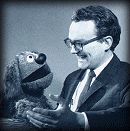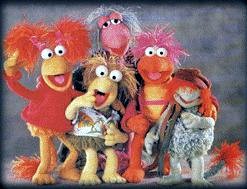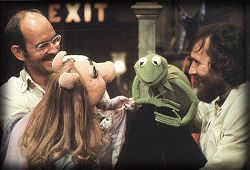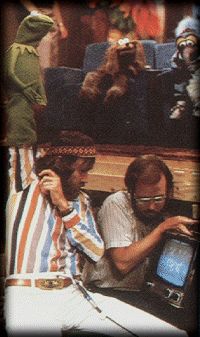| A
R T I C L E S |
New Collectibles •05/25 - NECA Sesame Street: Count Von Count Ultimate Action Figure
•04/25 - Reaction Sesame Street: Big Bird and Snuffy •03/25 - NECA Sesame Street: Ernie Ultimate Action Figure, Bert Ultimate Action Figure
•03/25 - Boss Studios Fraggle Rock: Boober Action Figure, Wembley Action Figure, Mokey Action Figure, Sprocket Action Figure •08/24 - Reaction Sesame Street: Big Bird, Mr. Hooper, Sherlock Hemlock, Super Grover |
||
|
|
|

|
|
|
Jerry Juhl joined Jim Henson in 1961. He originally was a performer to replace Jane Henson, however, Jerry soon settled in as the Muppets writer. |
HENSON: Yes, he was still doing Fraggle Rock while we had to write the Miss Piggy show, so that's why we went outside to Buzz Kohan and Henry Beard. Did you like the show?
I really liked it and it looked to me like a pilot, was it?
HENSON: No, no, not particularly. We have no intention of doing another one.
That's a shame. It's not until I got into doing the research on this and started looking at the old Muppet Show episodes and reading about them in Of Muppets and Men - The Making of the Muppet Show that I realized how much I miss it. I realize that 5 years of doing that kind of intensive work is a long time, but I just like those characters so much.
HENSON: Yeah, well, it's a quandary because I love the characters too and I want to keep them alive. I don't want to let them disappear. We all love them. Every time we get together and work the characters, we have such a good time, but at the same time, we never intended to do more than about 5 years. We wanted to stop while we still felt the show was fresh.
But you're going to bring them back for periodic specials and things, aren't you?
HENSON: Yeah, oh sure, yeah, we have specials. We have plans for another movie.
Will this third movie have no human beings like The Dark Crystal, or are you going to have guest stars again?
HENSON: The script that we're working with right now has them in New York City mostly and they're trying to make it on Broadway.
Oh, great! As a matter of fact, that's farther down on my list of questions here but, in articles and interviews with you in the 60s, you seemed to be hinting that there was going to be a Broadway show that you were working on. Was that a Muppet or puppet project, and is that still a possibility or has that been taken over by your ice and arena shows?
HENSON: Well, no not really. It's interesting. Well, it was a different show back in those days. I was actively building a show when we got The Muppet Show, so I shelved that whole project and we went over to London and got into The Muppet Show, but now I'm still working on a concept for a Broadway show which is probably a couple of years away. It's not the Muppets, but it's very exciting.
Is it puppets or something like that?
HENSON: Yeah, yeah, it's puppets and a mixture of all kinds of other things, too.
Sounds great!
HENSON: Well, if we get it together, it'll be a lot of fun.
|
|
|
The main five Fraggles are Red, Wembley, Mokey, Gobo, and Boober. |
With a project like Fraggle Rock, which you create from scratch, you didn't have to get anyone's permission or sponsorship or anything. With something like that, who creates the names of the Muppets - do you come up with them or the writers or who?
HENSON: The whole project has been fun because it was very collaborative. We invited a bunch of our people and some of our friends together and we sat around a room for several days with a couple of different sessions. During that period of time, we cooked up the whole scheme and the names fell into place. The Fraggle names - some of them are fun - came from different places. Boober is one of my favorite names. There's a character in Fraggle Rock named Boober. My daughter was in Devon at a farm, and there was this cow - this angry cow because they'd taken her calf away - an angry cow named Boober. And she came back and told me this story of this cow, and we were just laughing hysterically and I said we have to find a character and name him Boober because it's such a great name. Then Fraggle Rock came along a number of months later and so there's Boober on Fraggle Rock now.
In 1978 there were over 500 Muppets, so there must easily be many more by now. Do you have any idea how many Muppets there are?
HENSON: You know, I don't really know. I couldn't begin to guess actually.
When they're not being used, are they all in your various buildings on 69th Street - is that where they're housed?
HENSON: No, we have a lot of storage - we have theatrical storage in New York because we built up - they're quite bulky, you know, particularly the large characters, and so we couldn't begin to store all the stuff in our place.
So how do you keep track of them? Is there some one place where they're all inventoried?
HENSON: Yeah, yeah, we have boxes and they're all carefully labeled and that sort of thing, and we do go back and pull them out for other shows.
|
|
|
Frank Oz and Jim Henson perform their most loved characters, Kermit and Miss Piggy on The Muppet Show. |
I know you used some of the Emmet Otter characters on The Muppet Show from time to time. How many copies do you make of major characters, like Kermit or Rowlf?
HENSON: Well, it varies just by the need. Actually the copies of characters is something I don't particularly like to talk about in articles but just for your information, most characters there's only one. Somebody like a Piggy or a Kermit, there needs to be several versions and so there will be several of them. I'm not even sure how many because often we'll also have a photocopy – a character that's made that we use just for posing for photographs. It would be armatured, that sort of thing, but I don't think it's good to talk about that particularly. I remember hearing that there were several Lassies, and I never liked knowing that sort of thing.
She couldn't have been alive all these years. I mean, she'd be 200 and something.
HENSON: No, but besides that Lassie was always male, which was another one of those disillusioning pieces of information you don't want to know.
I guess not. Well, I guess you don't want to tell me how often the Muppets wear out.
HENSON: That's the same story. Actually, they don't wear out that much really.
The original Ernie and Bert are in the Smithsonian. Do you have a place that you put other worn out Muppets, or does your staff just take them home or what?
HENSON: No, actually, they're basically all in storage. We have all of that stuff together. We don't release Muppets out hardly ever. There's one Kermit in the Detroit Institute of Arts and Ernie and Bert in Washington and that's about all.
OK, the next question may also be something that you don't want to answer, but I have it down here. So how much does it cost to make a Muppet from the amount of time that somebody spends from the initial sketch and all the materials that it takes and the time to costume it?
HENSON: You can't really put a figure on it. The cost of the material is usually negligible because you're not using that much of hardly anything, so it's really all time and labor and that varies a great deal. If you're doing a large, complicated character with radio controls, it might take a number of people several months to make it and if you're talking about a quick little hand puppet, it could be made in 2 days, so there's enormous range there, and no real easy generalities.
But once you create a puppet, isn't it that much easier to make a duplicate of it, once you've gone through all the...
HENSON: Strangely, no, with major characters in particular. Any time we have to duplicate Ernie and Bert, for instance, we all cringe because they're very, very difficult to duplicate, much harder to do than the first ones.
Why is that 'cause they don't even have that many features. They just have, you know, that big eyebrow...
HENSON: Yeah, there's an incredible subtlety to the placement of the eyes and the planes of the shape that they're made of, and if any of those things are off just slightly, the character doesn't look the same. You can't put your finger on it. You study and measure it with calipers and all that sort of thing, but the first time you build a puppet, you just toss it together and it's fine, but then you've got to build the next one exactly like that, and we all go crazy. But besides that, you see, as you work with the puppet, it wears out, and as it ages it changes and the nature of the fabric changes, the hair. Then you come back to do it again and you've got brand new fabric and so it doesn't look anything like it. It's always been a big problem.
It's interesting when I was allowed to walk through the workshop, and there were all these Muppets that were on racks and they all look so lifelike - as though they were going to start talking to me any minute - except Kermit, who was just this limp thing. It never ceases to amaze me the amount of emotion that Kermit can convey for a character that is so basically simple - doesn't have movable eyes and just...
|
|
|
Jim Henson operates Kermit for the opening scenes of The Muppet Movie. Muppeteers use a monitor so that they can see the same scene that the audience does. |
HENSON: Yeah, well, the nice thing about Kermit is there's nothing in that head. I mean, the whole shape is merely just a cloth pattern and so it takes the shape of your hand inside, and so the whole thing is really created by your hand, which is why he's a delightful character to operate, too. He's so flexible and very responsive. One of the things we've always tried to do with any of our puppets is to try and get them flexible enough so that you have a wide range of emotions possible.
It's just amazing to me that you could do that with a hunk of felt. You know, a character that can't really curl his lip, for example, you can still put that kind of, I don't know...
HENSON: That's again one of the great things about puppetry. You do part of it and the audience fills in the rest.
I guess so, but I still think it's more your ability than in my mind.
HENSON: Well, it's a joint thing.
I can't believe how fast you work. You said you devote only 3 months to a special, and that includes one month writing for the first draft. And you only spend 3 months of the year on Sesame Street and you're involved in so many projects. You've got the TV series and the specials and the ice show and the traveling art exhibit, comic strip and theme park. How actively involved are you in the day-to-day creative aspects of all of these things?
HENSON: Well, it varies a lot. I think my own strengths are in television production. It's what I see as what maintains the thrust of us as a group and so that's really where I like to spend my time and energy. We have a marvelous group of people that are involved in our publishing programs and the art department working with different licensees trying to keep these things faithful. Basically, I review that kind of thing and try to stay in touch with the people and their problems, but I'm not working with that on a day to day basis.
How are new operators, new puppeteers trained and what do you look for when you recruit somebody? What skills do they have to possess?
HENSON: Well, let's see, generally we'll have a series of auditions. We'll contact all the different people who have contacted us since our last auditions, and we look for a whole combination of things. We look for a basic sense of performance, a sense of humor. We look for the type of person that kind of sparks to what you think everybody else would spark to. You have to find people who put their whole performance into their hand and that's a very specific talent that a lot of performers don't have. A lot of very funny performers will never be good puppeteers.
You're saying it's nothing that somebody could be taught.
HENSON: Well, it can be taught if there's a basic kind of receptivity there. It's hard to know. I so often don't know myself and so usually what we do is after that first series of auditions, we go through a workshop period where we'll take twice or three times as many people as we want to end up with. We'll take people who have no puppetry experience also. We'll work with all of them for a week and at the end of that time - if we think they have an ability there that looks like it'll work out - we basically know whether or not the person will become a good puppeteer or not. The whole process of learning our style and becoming good at it takes nearly a year, I would say, at least.
And that's just practicing lip-syncing for that whole year?
HENSON: It's not just lip-syncing, it’s all the other skills connected with what we do. And so generally what we try to do is whenever we're in production, we try to have a couple of people working with us on a - not exactly apprenticed - but the new people learning, a backup team in order to be able to grow into good puppeteers. A lot of it is just doing it because all of the stuff you just have to do it a lot until it gets natural and totally without thinking. So you don't have to think about how to lip-sync and you don't have to think about the monitor and the fact that the picture's reversed.
That's one of the things I could never get used to, the fact that you have to move left when you want the puppet to go right. My brain is just not set up that way.
HENSON: Right, right, but after you go through working with the monitor for a particular period of time, then it's totally automatic and you never even think about it.
In the films and even to a certain extent on the TV shows there's increasing use of radio-controlled devices and mechanical and hydraulic things. Do you envision the Muppets ever become completely, I don't know, robotocized, like these Walt Disney animatronic figures?
HENSON: Well, no, although one of the things that we're working with these days in Fraggle Rock is a way of performing a character completely outside. We have some little tiny characters in the show called Doozers. They're about 6 inches tall. We've been able to radio control their movement, so that one is outside operating a large thing, and it's all translated down to this little tiny thing. He can talk while he goes riding across on a motor scooter, but basically, the performance is still coming from the performer. And I think that always has to be a key thing to us. That all of the mechanical things and all of the radio-controlled stuff is always at the service of the performer in order to try to get a more complete performance. I think it's that sense of performance that is always essential to everything we've ever done. The automated shows very often look incredibly wooden to me because it's that sense of performance that's not there.
Yeah, you're more in awe of the fact that it's a machine doing this, you don't lose sight of the fact. You think, "What a wonderful machine," you're not thinking, "What a wonderful performance."
HENSON: Right, right, and the performance is where the humanity is, where the relationship is and I think that has to stay at the heart of it all.
The Henson people are not doing the voices for The Dark Crystal. Are well-known actors doing them?
HENSON: No. Some of our performers did their own voices but only a couple of them. Usually, because we felt that I was casting the performance in terms of performers. So really tying the type of character to the performer but not feeling that I wanted to lock to somebody who has the right voice, because in a film it's not difficult to find a voice for the type of thing that you want to do. That's almost easier than the performer.
So does this mark the first time that somebody else is doing a voice that they're not actually performing?
HENSON: No, not really. We've done bits of that all along, back from the days when we did Musicians of Bremen we used a number of voice people. In Emmett Otter we had a couple of voice people in that. I think we've always done a certain amount of that.
I guess I never picked up on it because your people do so many different voices, it's hard to really tell who is doing whom.
HENSON: Good.
I saw an ad in Publisher’s Weekly for The Tale of the Dark Crystal, which is a children's version of the story and I was surprised to see that it wasn't using Brian Froud's illustrations or production photographs. Why is that? Why did you get somebody else to do the illustrations?
HENSON: Yeah, Brian preferred not to do the book. I mean, we certainly offered it to him, if he wanted to do it. I'm trying to think what his reasons were at that point. I think probably he was tired, having spent a number of years on the film, and he didn't particularly want to go right in to doing the characters for the children's book, but he also had no objection to someone else doing it. Actually, we had another artist lined up and, for some reason, that fell through and so Bruce McNally, who's our art director in London, had to step in suddenly. Bruce is a brilliant illustrator who did, I think, an incredible job on this book. It's just a gorgeous book. It's really nice.
I read somewhere that you have an interest in psychic phenomenon. Is that true?
HENSON: Oh, just an outsider's interest and curiosity, I suppose. I love all that stuff.
I do too. Is there any special aspect of it that appeals to you?
HENSON: Well, let's see. A number of years ago I became quite interested in Seth, if you know anything about Jane Roberts' books. Jane Roberts wore a series of books from an entity called Seth. Those are the Seth books, which I particularly love and enjoy all the concepts in those. I haven't read them recently, I must say.
Isn't there one that is called Seth Speaks?
HENSON: Yeah, Seth Speaks is one of her early books.
Well, I've just about exhausted all my questions here.
HENSON: Oh, good.
I just really appreciate your taking the time to do this. I know you must be really exhausted after working all day and to have to sit and talk...
HENSON: It's night over here now, so it's time for me to go to sleep. OK, Judy, I've enjoyed talking to you. It's fun to talk to somebody who knows that much about us.
Well, I'm a long time fan and it's just a pleasure to have an opportunity to speak with you and tell you how much I love Kermit and all the characters and I hope to see them soon. I wish you really the very best luck with The Dark Crystal and Fraggle Rock.
HENSON: Gee, thank you so much. I look forward to meeting you some time.
Wow, me too, thank you very much.
HENSON: OK, Judy, good night.
Good night!
|
|
|
home | news | collectibles | articles | forum | guides | radio | cards | help
Fan site Muppet Central created by Phillip Chapman. Updates by Muppet
Central Staff. All Muppets, Bear
Muppet Central exists to unite fans of the Muppets around the world. |



